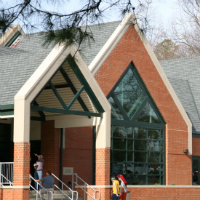
Charlie Maloney's class on sustainability and agriculture gives students theoretical and practical knowledge.


Charlie Maloney's class on sustainability and agriculture gives students theoretical and practical knowledge.

A study led by researcher Lisa Kellogg of William & Mary's Virginia Institute of Marine Science shows that a restored oyster reef can remove up to 10 times more nitrogen from Chesapeake Bay waters than an unrestored area nearby, providing additional evidence that reef-restoration can contribute to efforts to improve water quality in the nation’s largest estuary.

William and Mary recently participated in the annual RecycleMania Tournament for the fifth consecutive year. The competition ended on March 30, and W&M finished first in Virginia, topping schools such as University of Virginia, James Madison University and Virginia Tech.

William & Mary Professors John Swaddle and Stuart Hamilton have begun accepting applications for the College's new certificate program in Geographic Information Science for summer 2013.

Results from the VIMS-led seagrass monitoring program show that underwater grasses in Chesapeake Bay and its tidal rivers declined 24% between 2011 and 2012, approaching lows last reported in 1986.

The thing that looks like someone tossed a dirty mattress into the upper reaches of the Crim Dell pond is actually a floating artificial wetland, designed to help clean excess nitrogen from the water of the campus landmark.

Professor J. Emmett Duffy is the lead author on an article in the new issue of BioScience, which calls for establishment of a national network to monitor the diversity of marine life.

The Commonwealth Center for Energy and the Environment calls for its second round of proposal submissions. Proposal Submission Deadline: July 1, 2013

William & Mary’s Commonwealth Center for Energy and the Environment has launched its first round of projects, which have an emphasis on the effects of the rise of sea level.

For the second year, the Center for Conservation Biology is sounding the call to OspreyWatchers throughout the world to record and share their observations with a growing online community of global citizens that are linked by an interest in osprey biology and a concern for aquatic environments.

Professor Steve Kuehl is investigating whether river runoff from last year's Alaskan "Snowpocalypse" left a signature in nearby seafloor sediments, and if so, what the long-term record of such events might say about the area's fast-changing climate.

The Eastern Golden Eagle Working Group has received the Wings Across the Americas Award issued by the U.S. Forest Service.

Bob Diaz has co-authored a new report, commissioned by the U.N., that provides recommendations for managing the use of nitrogen and phosphorous in a world where the coastal waters of most developed nations suffer from excessive inputs of these and other nutrients.

Gong, a new faculty member at William & Mary's Virginia Institute of Marine Science, is a physical oceanographer who uses gliders and moorings to study the movement and properties of coastal waters.

The destructive Ash Wednesday Storm of 1962 captured the attention of teenager Asbury (Abby) Sallenger, Jr. Thirteen years later, he received his Ph.D. in marine science at VIMS, formalizing his life-long interest in beaches and the coastal hazards that threaten them.

Students, staff and faculty from VIMS took part in Virginia Sea Grant's 4th Annual Project Participants’ Symposium.

William & Mary’s four LEED-certified buildings have contributed to Virginia being named the top state for LEED certification in 2012 by the U.S. Green Building Council.

The ranking detailed how Alan B. Miller Hall is one of the most environmentally friendly buildings in the nation to house a business school.

A team of researchers from W&M's Virginia Institute of Marine Science joined with officials from the Chesapeake Bay Program and other agencies to announce the release of the latest Bay Barometer, CBP's annual report on Bay health and the status of long-term Bay restoration efforts.

A $4.49 million grant to an international team that includes researchers Robert “JJ” Orth, Ken Moore, and Scott Marion of VIMS will support efforts to develop innovative techniques and tools for restoring eelgrass.

A new report from W&M's Virginia Institute of Marine Science lays out a detailed plan for how the Commonwealth can best respond to the ongoing challenges that high tides, storm surge, intense rain storms, sinking land, and rising sea level pose to residents and localities along Virginia's Chesapeake Bay and Atlantic shorelines.